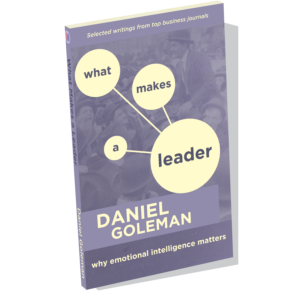

Leadership Training: Filling the Gap with Emotional Intelligence
May 11, 2018 Time to read: 5 min.The reality of the average worker is not improving, and the way people feel about their workplace relationships is a key contributor to the problem. Leaders at all levels struggle with issues of interpersonal interaction and employee engagement, many of which are likely tied to inadequate leadership training and support. Changes in the workforce further complicate the demands of leadership, challenging the effectiveness of the most widely accepted leadership theories. Fortunately, there is growing evidence that indicates what employees and leaders need to thrive, which includes a better understanding of the role of emotion.
Not the Trickle-Down Effect We Wanted
In 2017, CLO Media reported that U.S. companies invest as much as $24 billion annually in programs to develop leadership effectiveness, yet, during the same year, the Engagement Institute identified stressed leaders as a primary cause of employee disengagement, and linked this issue to an estimated annual cost of over $450 billion. A study by Steelcase reports that 1/3 of workers in 17 of the world’s most important economies are disengaged, and Gallup reported in 2015 that 50% of 7,200 adults surveyed left a job “to get away from their manager.” In addition, a Karolinska Institute study showed a strong link between negative leadership behavior and heart disease in employees, which further supports the claim that abusive supervisors are one of the most costly problems faced by businesses. (Additional references appear at the end of this article.)
The Role of Emotion in Performance
While it is impossible to link these problems to any single cause, the behaviors modeled by leaders in the workplace are clearly a contributing factor. This is often the context within which we hear about the importance of Emotional Intelligence in professional settings, recently identified as a core leadership requirement in Crack the C-Suite Code by former Cisco Global Executive Talent VP, Dr. Cassandra Frangos. Leveraging the role of emotions in workplace performance does not require alignment with any particular theory or school of thought in order to be solution oriented. We only need to acknowledge that employee and leader performance is influenced by emotions, and make that the starting point for interventions.
A Better Understanding of What Employees Need
It probably isn’t a stretch to say that most leaders are not adequately equipped to support the new demands emerging from the workforce. For example, introverts make up 30–50 percent of the workforce, but many organizations maintain workplace environments that introverts find counterproductive. Additionally, in the U.S. 31 percent of full-time employees report being unable to complete key tasks in their primary work locations, and 41 percent report lacking access to privacy needed for confidential workplace conversations. It is also estimated that as many as 20 percent of adults will develop PTSD at some point in their lives, and 18 percent suffer from anxiety disorders. This data raises the question of whether current and future generations of leaders are adequately prepared to provide for the emotional needs of employees.
We also continue to hear about “issues” with the millennial workforce, the significance of which is well-articulated in a story about cultural changes at PwC that describes the unwillingness of younger, key employees to give up quality of life in exchange for continued employment. This forced the organization to change on a fundamental level, and illustrates the point that leaders must be prepared to adapt to the needs of workers now more than ever.
A Call for Emotional Intelligence
Fortunately, studies identifying the negative effects of inadequate leadership often also shed light on possible solutions. For example, the previously mentioned Karolinska study showed that employees with inspirational managers reported less short-term sick leave. In addition, workers whose managers hold regular meetings are three times more likely to be engaged. Employees have also reported a desire for daily contact with their boss, and for their superiors to take an interest in their personal lives. Finally, a Gallup report states that “clarity of expectations is perhaps the most basic of employee needs and is vital to performance,” which further adds to the argument for leader EI training aimed at increased engagement, since some research reports that engaged employees outperform disengaged employees by 202%.
Coaching as an Effective and Vital Strategy
There has been no shortage of training materials generated over the years with the aim of developing Emotional Intelligence in leaders. Given the data highlighted above, these efforts have not been adequate. The solution lies in approaching the problem with greater accountability, structured learning, and evidence-based strategies for lasting, behavioral change.
Optimal learning and retention has been linked to Direct Instruction, which should include contextualized and hands-on learning of new skills, concepts, and processes. Mentor and/or coach support is also required to facilitate the transfer of new knowledge into more effective capabilities. This process includes attention to the difference between what a learner can do independently and what can be accomplished with the support of more experienced advisors. Dixon, Carnine, and Kameenui (1993) indicate that this type of development requires metaphorical “scaffolds,” created and maintained by more knowledgeable others, which are “gradually dismantled” in order to enable independent function.
These theories stress the importance of a third party to guide development, which is also a foundation of a scientifically supported psychological modality, Cognitive Behavioral Therapy (CBT). The CBT approach focuses on identifying thoughts, beliefs, and reactions that contribute to ineffective behavior, and learning how to manage this process. The adaptation of CBT for the specific purpose of addressing the requirements of leadership coaching has already been proposed, and the combination of this approach with more effective learning strategies is exactly what the next generation of workplace Emotional Intelligence development should be based on.
This means that coaches and mentors should be an integral part of EI training. It also means that programs will need to reach employees at all levels of organizations to begin creating internal networks of EI coaches and communities of EI practitioners. If there is one thing we can probably all agree on about EI, it is that the way people treat one another has a direct impact on workplace performance. From that perspective, workplace EI development should focus on creating environments where employees and leaders are fluent in a common language and theoretical framework for better understanding one another’s needs.
Recommended Resources:

For more in-depth reading on leadership and EI, What Makes a Leader: Why Emotional Intelligence Matters presents Daniel Goleman’s ground-breaking, highly sought-after articles from the Harvard Business Review and other business journals in one volume. It features more than half a dozen articles, including “Reawakening Your Passion for Work.”
References:
3. “1/3 of workers in 17 of the world’s most important economies are disengaged”
4.”50% of the 7,200 adults surveyed left a job ‘to get away from their manager'”
5. “abusive supervisors are one of the most costly problems faced by businesses”
6. “as many as 20 percent of adults will develop PTSD at some point in their lives”
7. “18 percent suffer from anxiety disorders”
8. “Employees have also reported a desire for daily contact with their boss”
9.”scientifically supported psychological modality, Cognitive Behavioral Therapy (CBT)”







